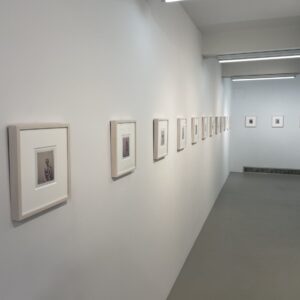JTF (just the facts): Published in 2023 by Van Zoetendaal Publishers (here). Softcover with dust jacket (14.8 x 19.6 cm), 120 pages, with 108 plates. Includes an essay by Wilco Versteeg (in Dutch, with English text on insert paper), and a shorter text by Willem van Zoetendaal. In an edition of 750 copies. Design by Willem van Zoetendaal. (Cover and spread shots below.)
Comments/Context: Mark van den Brink, an Amsterdam-based photographer, takes photographs using a subminiature (8×11 mm) Minox camera, the smallest usable camera in the world. It was designed in 1936 by Walter Zapp, with the idea to produce a compact device that was easy to carry, user friendly, and affordable. Yet with its high production costs, the Minox became a luxury gadget, that is when it wasn’t being used for spycraft and espionage.
The Minox also found its way into popular culture, and has been featured in a number of movies. Van den Brink first noticed the camera in Robert Altman’s movie “Prêt-à-Porter”, and bought one in a second-hand shop in the early 1990s, during his last year at the Gerrit Rietveld Academy in Amsterdam. He liked the idea of taking photographs unnoticed, but he also became fascinated by the coarse grain and imperfections that found their way into the prints. During a trip through the Alps, he experimented by fastening this camera to a pair of binoculars or a telescope, the resulting images making the mountains feel both close at hand and even further away. His first photobook titled The Minox Files is a unique visual diary he created using this small spy camera, and still experimenting, his newest project Stills & Stones gathers together studio still lifes made with this same camera between 2004 and 2023.
Stills & Stones immediately stands out as a carefully crafted object. It has a comfortable size and is joyful to hold and browse. An image of a sculpture arranged from a dozen or so blocks appears on the dust jacket printed on thick transparency paper, and the title is placed in a small font near the top right corner. Inside, the page numbers elegantly appear in a small font at the top of each page, a thoughtful and unexpected design decision. Most of the photographs are presented in the same size, usually appearing one or two per spread. Occasional blue stitches, complementing the book’s blue endpapers, are another great design choice. An essay by Willem van Zoetendaal, the publisher of the photobook, appears closer to the end and offers some background on van den Brink’s series, and together with excellent production and printing, the result is a beautiful and exciting art object.
All of van den Brink’s photographs were shot in his studio, without the addition of flash or extra light, just using the natural daylight coming through the skylight and windows and a simple canvas tarp as a backdrop. Shooting with the tiny Minox camera required a new approach for this series. The camera has the smallest negative in all of analog photography, and the custom film rolls are also quite expensive, so van den Brink cut his own film down to size (and since this cutting is done in the dark, the film occasionally gets scratched, adding additional darkroom imperfections). From there, he gathered various stones, and started to obsessively experiment with light and shadows. This passionate engagement is felt strongly through his deceptively simple and poetic photographs.
Stills & Stones opens with a photograph of a toy rabbit placed on a tall stool, shot from the back in the studio. The photographs that follow show various stones positioned on pedestals or stools, and van den Brink deliberately plays with scale, making it tricky to figure out the actual size of the objects in these pictures. The duotone color of the prints is richer and more subtle than just simple black and white, bringing out the complexities and nuances of the simple setups.
One spread opens to a horizontal photograph of a stone placed across the gutter allowing us to really notice its coarse texture, with the visible blue stitches that run through the image adding to the physicality of the experience. It’s the kind of image that rewards slow looking, noting its grain, color, and shadows. As the pages turn, we then encounter a parade of other objects, including a broom, a ladder, and a mop.
During his years of ongoing experimentation, van den Brink has also added in other cameras and formats to his repertoire, opened up further possibilities of color and composition. One later spread pairs a close up of a steep-roofed wooden house built by the artist with a photo of the artist himself sitting on a miniature chair made with thick birch branches, with his face partially out of frame. Then the photographs switch to square format, and the subject becomes more abstract, showing circular shapes in throbbing colors. These turn out to be photographs of ceramic vases van den Brink has started to make, also shot with a plastic camera at very close range. It seems he restlessly keeps experimenting, finding new ways to get excited within a constrained set of variables.
There is a lush playfulness to van den Brink’s visual vocabulary that makes Stills & Stones surprisingly seductive. It’s a clever project, filled with unexpectedly tactile photographs, all wrapped up in a tightly thoughtful photobook design. It’s an obscure and perhaps even eccentric book, but still altogether enchanting and memorable.
Collector’s POV: Mark van den Brink is represented by Gallery Fifty One (here). His work has little secondary market history at this point, so gallery retail likely remains the best option for those collectors interested in following up.





















